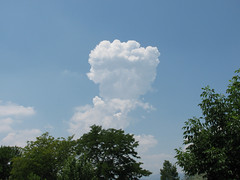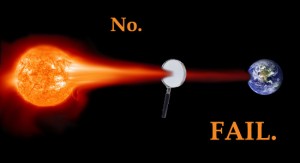 The way some of the media report on climate change can be simply stunning. For example, an opinion piece in The Financial Post has the headline “New, convincing evidence indicates global warming is caused by cosmic rays and the sun — not humans”.
The way some of the media report on climate change can be simply stunning. For example, an opinion piece in The Financial Post has the headline “New, convincing evidence indicates global warming is caused by cosmic rays and the sun — not humans”.
There’s only one problem: that’s completely wrong. In reality the study shows nothing of the sort. The evidence, as far as the limitations of the experiment go (that’s important, see below), do not show any effect of cosmic rays on global warming, and say nothing at all about the effect humans are having on the environment.
What did you do, Ray?
OK, first things first: why should we even think cosmic rays might affect climate? There are several steps to this, but it’s not too hard to explain.
We know that clouds form by water molecules accumulating on seed particles, called condensation nuclei. The physical processes are complex, but these particles (also called aerosols) are suspended in the air and water droplets form around them. The more of them available, the better water can condense and form clouds (although of course this also depends on a lot of other things, like how much water is in the air, the temperature, the height above the ground, and so on).
Cosmic rays, it turns out, may play a role in this too. They are subatomic particles that zip through space at high speed. We are bombarded by them all the time, in fact! They hit atoms and molecules in the Earth’s atmosphere, depositing their energy there. This affects aerosol formation rate, and therefore might affect cloud formation. Clouds are bright and white, and reflect sunlight. Therefore they affect global warming.
So the whole idea goes like this: the more cosmic rays there are, the more aerosols are made, the more easily clouds can form, the more sunlight gets reflected back into space, and the less global warming we get. It’s controversial, for sure (Discover Magazine interviewed a proponent of this idea in 2007) but worth looking into.
ConCERNing clouds
In practice, the actual connection between cosmic rays and cloud formation is really hard to determine. So a group of scientists at the European particle lab CERN decided to test the basics. They created a cloud chamber, bombarded it with cosmic rays, and examined the results. They found two very interesting things:
1) The number of aerosols created went up vastly as the particles blasted the chamber. That would seem to indicate that cosmic rays really are tied to global warming. Except…
2) The actual total number of aerosols created was way below what’s needed to account for cloud formation. Sure, there were more aerosols, but not nearly enough.
In fact, in the abstract of the paper itself, the authors state:
However, even with the large enhancements in rate due to ammonia and ions, atmospheric concentrations of ammonia and sulphuric acid [i.e. aerosols] are insufficient to account for observed boundary-layer nucleation.
 Let me be clear: there may yet turn out to be a connection between cosmic rays and cloud formation. Perhaps cosmic rays are the first step in a many-step process that enhances aerosols via different methods, making enough to trigger clouds. It’s possible, and since they created a lot of aerosols in their rig it’s worth pursuing.
Let me be clear: there may yet turn out to be a connection between cosmic rays and cloud formation. Perhaps cosmic rays are the first step in a many-step process that enhances aerosols via different methods, making enough to trigger clouds. It’s possible, and since they created a lot of aerosols in their rig it’s worth pursuing.
However, this study shows that under the conditions of the experiment, the effect of cosmic rays by themselves is too low to trigger cloud formation at the rates actually seen in our atmosphere. What is very clear is that any claims at this time that cosmic rays definitely affect global warming are baloney. As the authors of the experiment say, this is a good first step but there’s a long way to go to understand this problem, and as the website PhysOrg reiterates, “Though this most recent experiment doesn’t really answer the question of whether cosmic rays are having an impact on our weather, it does open the door to more research.”
Not just a river in Egypt
So why did the Financial Post run with a headline that says the exact opposite of what the study actually found? They’re not alone, either; the Telegraph has a blog filled with similar dubious statements about the study (mostly quoting from the Financial Post blog, so take that into account). The claim they both make is that some of the science was suppressed, but that’s thin air. And it’s certainly not enough to state with certainty that cosmic rays affect our climate.
And my irony gland explodes every time I hear a global warming denier say that the science has become politicized (as the Financial Post OpEd piece did, and as Rick Perry does). Ya think? The problem isn’t the politization of global warming (since by its very nature the changing climate affects everyone, and is therefore a concern of politics), it’s the attacks on the science based on politics.
The Sun is out
 A lot of global warming deniers try very hard to connect global warming to the Sun. In this case, the thinking is that Sun’s magnetic field affects how many cosmic rays hit the Earth – in times of lower solar activity, the Sun’s magnetic field doesn’t protect us as well from cosmic rays, so we should see more clouds at solar minimum and therefore cooler temperatures. During higher activity, the Sun’s field protects us better, so there should be fewer clouds, and more warming.
A lot of global warming deniers try very hard to connect global warming to the Sun. In this case, the thinking is that Sun’s magnetic field affects how many cosmic rays hit the Earth – in times of lower solar activity, the Sun’s magnetic field doesn’t protect us as well from cosmic rays, so we should see more clouds at solar minimum and therefore cooler temperatures. During higher activity, the Sun’s field protects us better, so there should be fewer clouds, and more warming.
The problem here is two fold: there doesn’t appear to be a large variation in Earth’s temperatures with solar activity*, and also that temperatures are rising extremely rapidly in the past 100 years, when solar activity has been relatively normal.
I researched this quite a bit for my book, “Death from the Skies!” It seems like an amazing idea, and well worth investigating, that cosmic rays could affect us so much that our weather might change due to them! But what I found then, as it still seems true at least for now, is that if cosmic rays do have an effect, it’s very small, and not nearly enough to account for either the suddenness or the amount of rise in temperatures the Earth has seen in the past century.
We may know more about any alleged connection in the next few years, but be very, very wary of anyone claiming with certainty that the Sun is causing our temperature rise, or that global warming is due to cosmic rays (or in this case, the lack thereof).
As I’ve said before, here are the facts:
The Earth is warming up. The rate of warming has increased in the past century or so. This corresponds to the time of the Industrial Revolution, when we started dumping greenhouse gases into the atmosphere. Greenhouse gases warm the planet (hence the name) – if they didn’t we’d have an average temperature below the freezing point of water. Carbon dioxide is a greenhouse gas which is dumped into the atmosphere by humans to the tune of 30 billion tons per year, 100 times the amount from volcanoes. And finally, approximately 97% of climatologists who actually study climate agree that global warming is real, and caused by humans.
* This is at best just a very small fluctuation, attributable to the actual changing amount of light and heat the Sun emits over its cycle. Basically, sunspots change the amount of light the Sun emits, but only by a teeny amount. And this amount goes up and down with each cycle, while Earth’s temperature have been increasing with time.
Related posts:
- Case closed: “ClimateGate” was manufactured
- New study clinches it: the Earth is warming up
- Is global warming solar induced?
- Cosmic rays and global warming
- No, a pole shift won’t cause global superstorms